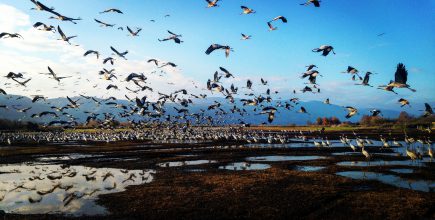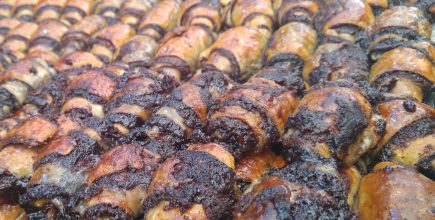Call us today!
+1-917-9055850
Magazine

Hiking in Israel
Just like in the famous Hebrew song by Rami Kleinstein, Israel is a tiny country with many wonders.
Snowy Mount Hermon, evergreen Galilee forests, rocky Judean desert, and many flowing streams – nature has never seen this amount of diversity crammed in a small country that is no bigger than New Jersey.
Each area offers unique hiking opportunities with colorful vistas and interesting natural phenomena, and there is enough for everyone.
When searching for hiking routes, you should definitely look into the famous “Israel trail”, in Hebrew – “Shvil Israel.”
1050 km (652 miles) long, it is a cross-country trail that stretches from the foot of Mount Hermon in the north to the shores of the Red Sea in the south, and covers the country’s entire geographical area.
It can take a few weeks to complete the trail, however, if you don’t have the time, you can do a smaller section of it in your preferred area.
It is quite easy to explore Israel even for first-time hikers, since most of the trails are marked.
Walking is one of the best ways to explore, and while we do not expect you to walk across the entire country, we strongly recommend including nature in your trip to Israel. We hope that this article will help you prepare for hiking in Israel. Following is a list of our most recommended Israeli trails, arranged from north to south.
1. Banias Reserve’s Suspended Trail
Located in the vast Hermon Stream Nature Reserve, it is one of the prettiest trails in Israel. It goes through a lush and evergreen landscape, which includes a visit to an ancient Roman city, a walk along the riverbank of one of the Jordan River sources, and a suspended bridge that stretches over a series of beautiful waterfalls.
Banias has the most powerful waterfall in Israel, which flows throughout the year.
This hiking trail is family-friendly and can be done all year round.
2. Mount Meron Trail
Mount Meron is the highest mountain in the Galilee (1208 meters). Its summit offers a beautiful circular trail that is about 2 km long. This route is family-friendly and is rich with breathtaking views of the Galilee, Golan Heights, Mount Hermon, and even Southern Lebanon. The mountain was declared a nature reserve way back during the British Mandate period. Due to a high amount of precipitation, beautiful flowers can be observed blooming in the spring and autumn.
3. Gilabon
One of the most popular hiking experiences in the Golan Heights, you can travel the Nahal Gilabon trail in two ways via a 3 km loop trail or 5 km trail with different starting and finishing points. Both trails are great, and include a visit to the remains of a Talmudic village, impressive waterfalls, water hikes, and the beautiful landscape of the Galilee and Hula Valley.
This hike is family-friendly and is considered of moderate difficulty level.
4. Nahal Kziv and the Montfort Fortress
Nahal Kziv is one of the most beautiful bio-reserves in Israel. The entire area consists of the Kziv stream that stretches over 140 km (86 miles) from the foot of Mount Meron to the Mediterranean coast, and cuts through the Upper Galilee mountains, creating a dramatic landscape filled with sharp cliffs and lush Mediterranean scrubland.
The bio reserve offers many hiking options with a variety of loop and point-to-point trails with difficulty levels ranging from moderate to advanced.
The stream flows all year round thanks to the high precipitation on Mount Meron, and the various springs along its route. All trails include access to water.
We highly recommend including a visit to the beautiful Montfort Fortress located in the heart of the reserve.
5. Sataf
Located in the heart of Jerusalem Mountains, Sataf nature reserve is a great example of biblical agriculture.
The scenery is dominated by mountains covered with terraces, which are fed by several springs flowing to this day.
Ancient communities used the terraces as a unique irrigation technique that allowed better cultivation of the mountain fields.
The crops that once covered the terraces were replaced by a lush woodland with seasonal flower blossoms.
This area offers many hiking options, ranging from easy to moderate difficulty level. All trails are family-friendly and we highly recommend visiting one of the springs.
6. Wadi Qelt
This flourishing oasis, called Wadi Qelt in Arabic and Nahal Prat in Hebrew, is located in the Judean Desert. Three large springs feed the Qelt stream, which cuts through the landscape creating a powerful canyon that stretches from the mountains of Jerusalem to the Dead Sea.
The stream is identified with the Cherith brook mentioned in 1 Kings 17, where Prophet Elijah was fed by ravens and drank from the water source.
Around the fourth century, a monastery was built on the side of the cliffs. This is the first monastery created in the Judean Desert, and it was named after a Christian hermit – Saint Chariton.
The most popular hiking option is a loop trail, which includes the springs and an opportunity to go up to the Monastery.
Please note that during certain days of the week, the monastery allows entrance to male visitors only.
7. Ein Gedi
Located in the Judean desert close to the shores of the Dead Sea, this is the most popular site amongst trackers.
Four large springs emerge from the cliffs, creating a series of waterfalls and a beautiful ecosystem with diverse flora and fauna.
The most impressive waterfall comes from a spring, named after King David. According to the Bible, King David hid from King Saul in one of the caves in the reserve.
Make sure to pay attention to the permanent residents of Ein Gedi – the ibexes and hyraxes, which can be observed regularly, nibbling on the leaves of the acacia trees or just resting in the crevices of the cliffs.
Ein Gedi offers many hiking options. Whether you choose the short or long trail, make sure to grab a pair of good hiking shoes and a bathing suit to enjoy the cool spring water pools.
8. Ein Avdat
Another beautiful oasis, this time in the heart of the Negev Desert.
Nestled deep in the Tzin Canyon, Ein Avdat is a nature reserve with 3 springs that feed a lush ecosystem.
The landscape is truly unique, with the Tzin cliffs towering above the springs, creating a narrow gorge with mesmerizing pools.
Various animals are attracted to the oasis, the most famous of which is the griffon vulture that dominates the skies of Ein Avdat.
The site was named after the ancient city of Avdat, which was built above the reserve by the Nabateans.
Another point of interest in the area is David Ben-Gurion’s tomb overlooking the Tzin Canyon.
9. Nahal Nekarot
The list would not be complete without the “Makhteshim” (craters) of the Negev Desert.
The Ramon Crater (Makhtesh Ramon) presents multiple hiking options, one of which is Nahal Nekarot – a seasonal watercourse that drains the Makhtesh and is rich with interesting geological phenomena.
The loop trail is of moderate difficulty, takes around two hours to complete, and is highly recommend during winter, after the flash floods.
Don’t miss the remains of a Nabataean inn that used to accommodate incense-carrying convoys around 2000 years ago.
10. Red Canyon
Situated in Eilat Mountains, the Red Canyon was formed by a seasonal stream that cuts through the red sandstone, creating a meandering trail in the deep gorge.
The narrow passage leaves its visitors speechless and captivated with the beautiful shades of red, which indicate different concentrations of iron oxide.
Some parts of the trail have rungs and ladders and therefore, it requires medium to advanced hiking skills.
Contact Us
Related articles
Tours and Activities

What to pack for your Israeli trip
Backpacking, family holiday or a group tour – packing is an integral part of any trip preparation. Not everybody is…

Bird migration to Israel
Israel – a crossroad between 3 continents – is situated on one of the busiest bird migration routes in the…

Israeli Cuisine
In recent years, culinary tours have become an essential experience of every trip abroad. Strolling through the markets and occasionally…